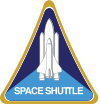STS-63
| Missionsemblem | |||||
|---|---|---|---|---|---|
 | |||||
| Missionsstatistik | |||||
| Missionsnavn: | STS-63 | ||||
| Rumagentur: | NASA | ||||
| Rumfærge: | Discovery (20) | ||||
| Antal besætningsmedlemmer: | 3 | ||||
| Affyringsrampe: | LC-39B (KSC) | ||||
| Opsendelse: | 3 februar 1995 | ||||
| Landing: | 11 februar 1995 | ||||
| Landet på: | Kennedy Space Center | ||||
| Varighed: | 8 dage, 6 timer | ||||
| Foto af besætningen | |||||
 | |||||
| Navigation | |||||
| |||||
STS-63 (Space Transportation System-63) var Discoverys 20. rumfærge-mission.
Opsendt 3. februar 1995 og vendte tilbage den 11. februar 1995.
Missionen var rumfærgernes 1. tur til rumstationen Mir og 2. mission med russisk deltagelse, den første var STS-60.
Efterfølgende fælles missioner til Mir: Sojuz TM-21, STS-71, STS-74, STS-76, STS-79, STS-81, STS-84, STS-86, STS-89 og STS-91.
Besætning

 James Wetherbee (kaptajn)
James Wetherbee (kaptajn)
 Eileen Collins (pilot)
Eileen Collins (pilot)
 Bernard Harris (1. missionsspecialist og nyttelast-specialist)
Bernard Harris (1. missionsspecialist og nyttelast-specialist) /
/
 Michael Foale (2. missionsspecialist)
Michael Foale (2. missionsspecialist)
 Janice Voss (3. missionsspecialist)
Janice Voss (3. missionsspecialist)
 Vladimir Titov (4. missionsspecialist)
Vladimir Titov (4. missionsspecialist)
Hovedartikler:
| Wikimedia Commons har medier relateret til: |
Eksterne henvisninger
- STS-63 NASA (engelsk)
| ||||||||
| ||||||||||||||||||||
Medier brugt på denne side
SVG version of PNG Space Shuttle Logo/Patch.
SPARTAN 204 freeflying during STS-63 mission. The blackness of space and part of Earth's horizon form the backdrop for this 70mm frame of the free-flying SPARTAN 204 mission. Carried into space by the STS-63 crewmembers, the satellite was later re-captured by the crew and used for maneuvering evaluations by the two space walkers, astronauts Bernard Harris and Michael Foale.
Forfatter/Opretter: By Rei-artur (diskussion · bidrag)., Licens: CC-BY-SA-3.0
Venus/female symbol.
STS-66 Mission Insignia
STS-63 Mission Insignia
This picture of the Russian space station Mir over the Pacific Ocean was recorded by the Space Shuttle Discovery in February 1995. During this mission Discovery performed a rendezvous and "fly around" with Mir in preparation for a future docking mission.
STS-67 Mission Insignia
Forfatter/Opretter: Rei-artur (diskussion · bidrag), reshaped by F l a n k e r (talk), Licens: CC-BY-SA-3.0
symbol of Mars. 400 × 400 pixels nominal dimensions, line 45 pixel tick, circle 295 × 295 pixel, not joined with arrow. Colour: red=0 green=0 blue=140.
![]() Vektorgrafikken blev lavet med Inkscape.
Vektorgrafikken blev lavet med Inkscape.
Rotated and color enhanced version of original (ISS013-E-48788 (6 July 2006) --- The Space Shuttle Discovery approaches the International Space Station for docking but before the link-up occurred, the orbiter "posed" for a thorough series of inspection photos. Leonardo Multipurpose Logistics Module can be seen in the shuttle's cargo bay. Discovery docked at the station's Pressurized Mating Adapter 2 at 9:52 a.m. CDT, July 6, 2006.)
STS-63 Crew
- Crew members assigned to the STS-63 mission included (front left to right) Janice E. Voss, mission specialist; Eileen M. Collins, pilot; (the first woman to pilot a Space Shuttle), James D. Wetherbee, commander; and Vladmir G. Titov (Cosmonaut). Standing in the rear are mission specialists Bernard A. Harris (the first Afro-American to walk in space), and C. Michael Foale. Launched aboard the Space Shuttle Discovery on February 3, 1995 at 12:22:04 am (EST), the primary payload for the mission was the SPACEHAB-3. STS-63 marked the first approach and fly around by the Shuttle with the Russian space station Mir.

















